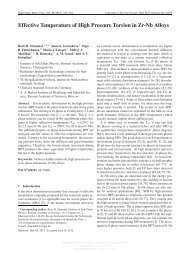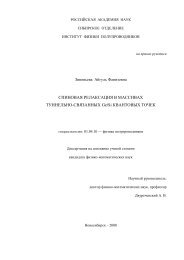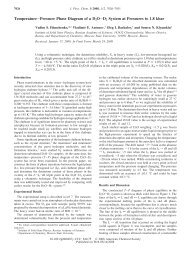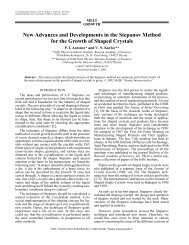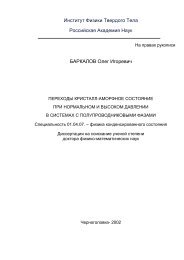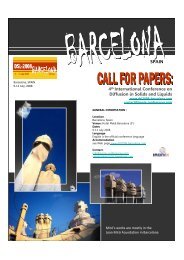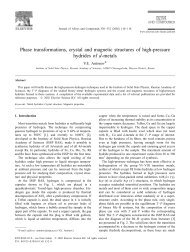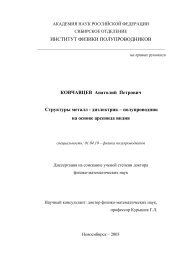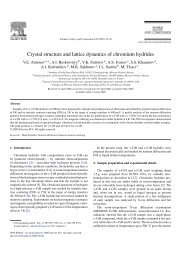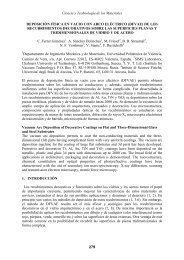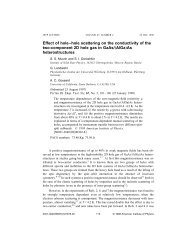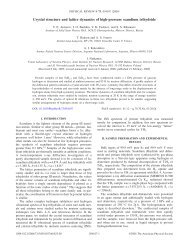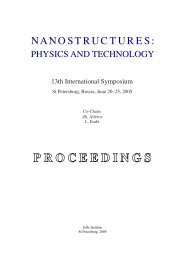- Page 1 and 2:
Superconductor edited by Adir Moys
- Page 3:
SCIYO.COM WHERE KNOWLEDGE IS FREE f
- Page 6:
VI Chapter 10 Chapter 11 Chapter 12
- Page 11 and 12:
1. Introduction A Model to Study Mi
- Page 13 and 14:
A Model to Study Microscopic Mechan
- Page 15 and 16:
A Model to Study Microscopic Mechan
- Page 17 and 18:
A Model to Study Microscopic Mechan
- Page 19 and 20:
A Model to Study Microscopic Mechan
- Page 21 and 22:
A Model to Study Microscopic Mechan
- Page 23 and 24:
A Model to Study Microscopic Mechan
- Page 25 and 26:
A Model to Study Microscopic Mechan
- Page 27 and 28:
1. Introduction The Discovery of Ty
- Page 29 and 30:
The Discovery of Type II Supercondu
- Page 31 and 32:
The Discovery of Type II Supercondu
- Page 33 and 34:
The Discovery of Type II Supercondu
- Page 35 and 36: The Discovery of Type II Supercondu
- Page 37 and 38: The Discovery of Type II Supercondu
- Page 39 and 40: The Discovery of Type II Supercondu
- Page 41 and 42: The Discovery of Type II Supercondu
- Page 43 and 44: The Discovery of Type II Supercondu
- Page 45 and 46: The Discovery of Type II Supercondu
- Page 47 and 48: The Discovery of Type II Supercondu
- Page 49 and 50: The Discovery of Type II Supercondu
- Page 51 and 52: The Discovery of Type II Supercondu
- Page 53 and 54: The Discovery of Type II Supercondu
- Page 55 and 56: The Discovery of Type II Supercondu
- Page 57 and 58: Microstructure, Diffusion and Growt
- Page 59 and 60: Microstructure, Diffusion and Growt
- Page 61 and 62: Microstructure, Diffusion and Growt
- Page 63 and 64: Microstructure, Diffusion and Growt
- Page 65 and 66: Microstructure, Diffusion and Growt
- Page 67 and 68: Microstructure, Diffusion and Growt
- Page 69 and 70: Microstructure, Diffusion and Growt
- Page 71 and 72: Microstructure, Diffusion and Growt
- Page 73 and 74: Microstructure, Diffusion and Growt
- Page 75 and 76: Microstructure, Diffusion and Growt
- Page 77 and 78: Microstructure, Diffusion and Growt
- Page 79 and 80: 4 Superconductor Properties for Sil
- Page 81 and 82: Superconductor Properties for Silic
- Page 83 and 84: Superconductor Properties for Silic
- Page 85: Superconductor Properties for Silic
- Page 89 and 90: Superconductor Properties for Silic
- Page 91 and 92: Superconductor Properties for Silic
- Page 93 and 94: Superconductor Properties for Silic
- Page 95 and 96: Superconductor Properties for Silic
- Page 97 and 98: Superconductor Properties for Silic
- Page 99 and 100: Superconductor Properties for Silic
- Page 101 and 102: Superconductor Properties for Silic
- Page 103 and 104: MgB2-MgO Compound Superconductor Yi
- Page 105 and 106: MgB 2-MgO Compound Superconductor t
- Page 107 and 108: MgB 2-MgO Compound Superconductor S
- Page 109 and 110: MgB 2-MgO Compound Superconductor F
- Page 111 and 112: MgB 2-MgO Compound Superconductor
- Page 113 and 114: MgB 2-MgO Compound Superconductor F
- Page 115 and 116: MgB 2-MgO Compound Superconductor T
- Page 117 and 118: MgB 2-MgO Compound Superconductor 4
- Page 119 and 120: MgB 2-MgO Compound Superconductor G
- Page 121 and 122: 1. Introduction Superconducting Pro
- Page 123 and 124: Superconducting Properties of Carbo
- Page 125 and 126: Superconducting Properties of Carbo
- Page 127 and 128: Superconducting Properties of Carbo
- Page 129 and 130: Superconducting Properties of Carbo
- Page 131 and 132: Superconducting Properties of Carbo
- Page 133 and 134: Superconducting Properties of Carbo
- Page 135 and 136: Superconducting Properties of Carbo
- Page 137 and 138:
Superconducting Properties of Carbo
- Page 139 and 140:
Superconducting Properties of Carbo
- Page 141 and 142:
Superconducting Properties of Carbo
- Page 143 and 144:
Superconducting Properties of Carbo
- Page 145 and 146:
1. Introduction Studies on the Gamm
- Page 147 and 148:
Studies on the Gamma Radiation Resp
- Page 149 and 150:
Studies on the Gamma Radiation Resp
- Page 151 and 152:
Studies on the Gamma Radiation Resp
- Page 153 and 154:
Studies on the Gamma Radiation Resp
- Page 155 and 156:
Studies on the Gamma Radiation Resp
- Page 157 and 158:
Studies on the Gamma Radiation Resp
- Page 159 and 160:
Studies on the Gamma Radiation Resp
- Page 161 and 162:
Studies on the Gamma Radiation Resp
- Page 163 and 164:
Studies on the Gamma Radiation Resp
- Page 165 and 166:
Studies on the Gamma Radiation Resp
- Page 167 and 168:
Studies on the Gamma Radiation Resp
- Page 169 and 170:
Studies on the Gamma Radiation Resp
- Page 171 and 172:
Charged Particle Irradiation Studie
- Page 173 and 174:
Charged Particle Irradiation Studie
- Page 175 and 176:
Charged Particle Irradiation Studie
- Page 177 and 178:
Charged Particle Irradiation Studie
- Page 179 and 180:
Charged Particle Irradiation Studie
- Page 181 and 182:
Charged Particle Irradiation Studie
- Page 183 and 184:
Charged Particle Irradiation Studie
- Page 185 and 186:
Charged Particle Irradiation Studie
- Page 187 and 188:
Charged Particle Irradiation Studie
- Page 189 and 190:
1. Introduction Application of Opti
- Page 191 and 192:
Application of Optical Techniques i
- Page 193 and 194:
Application of Optical Techniques i
- Page 195 and 196:
Application of Optical Techniques i
- Page 197 and 198:
Application of Optical Techniques i
- Page 199 and 200:
Application of Optical Techniques i
- Page 201 and 202:
Application of Optical Techniques i
- Page 203 and 204:
Application of Optical Techniques i
- Page 205 and 206:
Application of Optical Techniques i
- Page 207 and 208:
Application of Optical Techniques i
- Page 209 and 210:
Application of Optical Techniques i
- Page 211 and 212:
Application of Optical Techniques i
- Page 213 and 214:
10 Nanoscale Pinning in the LRE-123
- Page 215 and 216:
Nanoscale Pinning in the LRE-123 Sy
- Page 217 and 218:
Nanoscale Pinning in the LRE-123 Sy
- Page 219 and 220:
Nanoscale Pinning in the LRE-123 Sy
- Page 221 and 222:
Nanoscale Pinning in the LRE-123 Sy
- Page 223 and 224:
Nanoscale Pinning in the LRE-123 Sy
- Page 225 and 226:
Nanoscale Pinning in the LRE-123 Sy
- Page 227 and 228:
Nanoscale Pinning in the LRE-123 Sy
- Page 229 and 230:
Nanoscale Pinning in the LRE-123 Sy
- Page 231 and 232:
Nanoscale Pinning in the LRE-123 Sy
- Page 233 and 234:
Nanoscale Pinning in the LRE-123 Sy
- Page 235 and 236:
Nanoscale Pinning in the LRE-123 Sy
- Page 237 and 238:
Nanoscale Pinning in the LRE-123 Sy
- Page 239 and 240:
11 X-ray Micro-Tomography as a New
- Page 241 and 242:
X-ray Micro-Tomography as a New and
- Page 243 and 244:
X-ray Micro-Tomography as a New and
- Page 245 and 246:
X-ray Micro-Tomography as a New and
- Page 247 and 248:
X-ray Micro-Tomography as a New and
- Page 249 and 250:
X-ray Micro-Tomography as a New and
- Page 251 and 252:
X-ray Micro-Tomography as a New and
- Page 253 and 254:
X-ray Micro-Tomography as a New and
- Page 255 and 256:
X-ray Micro-Tomography as a New and
- Page 257 and 258:
X-ray Micro-Tomography as a New and
- Page 259 and 260:
12 Synthesis and Thermophysical Cha
- Page 261 and 262:
Synthesis and Thermophysical Charac
- Page 263 and 264:
Synthesis and Thermophysical Charac
- Page 265 and 266:
Synthesis and Thermophysical Charac
- Page 267 and 268:
Synthesis and Thermophysical Charac
- Page 269 and 270:
Synthesis and Thermophysical Charac
- Page 271 and 272:
Synthesis and Thermophysical Charac
- Page 273 and 274:
1. Introduction 13 Development of L
- Page 275 and 276:
Development of Large Scale YBa 2Cu
- Page 277 and 278:
Development of Large Scale YBa 2Cu
- Page 279 and 280:
Development of Large Scale YBa 2Cu
- Page 281 and 282:
Development of Large Scale YBa 2Cu
- Page 283 and 284:
1. Introduction 14 Some Chaotic Poi
- Page 285 and 286:
Some Chaotic Points in Cuprate Supe
- Page 287 and 288:
Some Chaotic Points in Cuprate Supe
- Page 289 and 290:
Some Chaotic Points in Cuprate Supe
- Page 291 and 292:
Some Chaotic Points in Cuprate Supe
- Page 293 and 294:
Some Chaotic Points in Cuprate Supe
- Page 295 and 296:
Some Chaotic Points in Cuprate Supe
- Page 297 and 298:
Some Chaotic Points in Cuprate Supe
- Page 299 and 300:
Some Chaotic Points in Cuprate Supe
- Page 301 and 302:
1. Introduction 15 Superconductors
- Page 303 and 304:
Superconductors and Quantum Gravity
- Page 305 and 306:
Superconductors and Quantum Gravity
- Page 307 and 308:
Superconductors and Quantum Gravity
- Page 309 and 310:
Superconductors and Quantum Gravity
- Page 311 and 312:
Superconductors and Quantum Gravity
- Page 313 and 314:
Superconductors and Quantum Gravity
- Page 315 and 316:
Superconductors and Quantum Gravity
- Page 317 and 318:
Superconductors and Quantum Gravity
- Page 319 and 320:
Superconductors and Quantum Gravity
- Page 321 and 322:
1. Introduction 16 Phase Dynamics o
- Page 323 and 324:
Phase Dynamics of Superconducting J
- Page 325 and 326:
Phase Dynamics of Superconducting J
- Page 327 and 328:
Phase Dynamics of Superconducting J
- Page 329 and 330:
Phase Dynamics of Superconducting J
- Page 331 and 332:
Phase Dynamics of Superconducting J
- Page 333 and 334:
Phase Dynamics of Superconducting J
- Page 335 and 336:
Phase Dynamics of Superconducting J
- Page 337 and 338:
17 Determination of the Local Cryst
- Page 339 and 340:
Determination of the Local Crystal-
- Page 341 and 342:
Determination of the Local Crystal-
- Page 343 and 344:
Determination of the Local Crystal-
- Page 345 and 346:
Determination of the Local Crystal-
- Page 347 and 348:
Determination of the Local Crystal-
- Page 349 and 350:
Determination of the Local Crystal-
- Page 351 and 352:
Determination of the Local Crystal-
- Page 353 and 354:
Determination of the Local Crystal-



